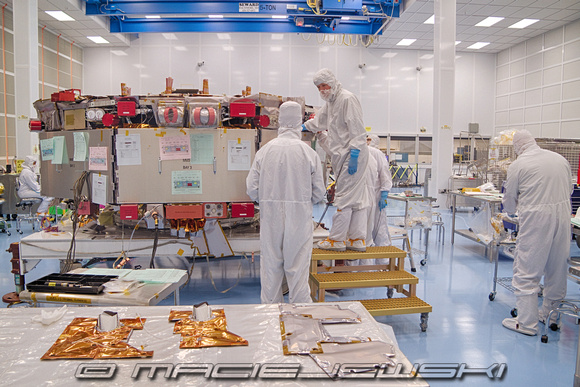Magnetospheric Multiscale Spacecraft (MMS)
The four MMS spacecraft will be developed, integrated, and tested at GSFC. Each satellite has an octagonal shape that is approximately 3.5 meters wide and 1.2 meters high. The satellites spin at 3 RPM during science operations. Low shock, commercial separation systems similar to the separation system used by the launch vehicle will separate the top three observatories in the launch stack. There are 8 deployable booms per satellite: four 60 meter wire booms in the spin plane for electric field sensors, two 12.5 meter booms in the axial plane for electric field sensors, and two 5 meter booms in the spin plane for magnetometers. The aluminum structure has a modular design to simplify I&T consisting of a propulsion assembly, separation system/thrust tube, instrument deck, and spacecraft deck. MMS Observatory DimensionsThe attitude control system keeps the spacecraft to within ±0.5° of the desired orientation during science operations and implements on-board closed loop maneuver control. Star sensors and sun sensors provide attitude sensor data, and accelerometers provide acceleration and delta-V data. Thrusters are used as actuators. The propulsion system is a mono-propellant blowdown system with 12 thrusters sized to achieve both small formation maintenance maneuvers and large apogee raise maneuvers. Approximately 360 kg of propellant will be contained in four titanium tanks per spacecraft. The Electrical Power System is a Direct Energy Transfer System employing a battery dominates bus. Power to the Spacecraft is supplied from 8 identical body-mounted solar array panels that are electrostatically and magnetically clean. The battery is sized to provide power during the 4 hour eclipses. The thermal design is passive using thermostatically controlled heaters. Ground communications occur over a single S-Band frequency for uplink to all four spacecraft and a single S-Band frequency for downlink from all four spacecraft. Real-time coverage of all critical commands, including post launch separation and all maneuvers, will be accomplished through TDRSSMMS Observatory description. The spacecraft bus avionics performs command and telemetry processing, timing distribution, solar array regulation, battery charge management, and thruster control. Orbit determination is performed on-board using weak signal GPS processing. Each satellite including instruments, fuel, and margin has a mass of approximately 1,250 kg. The power budget at end of life with instruments and margin is approximately 318 watts.
MMS Observatory InterfacesThe spacecraft will be developed using the standard GSFC protoflight testing approach. The first unit will be tested to qualification levels and the remaining units to acceptance levels. Design heritage from previous GSFC in-house development efforts will be used where possible, although each unit having heritage will go through the full design and test process. Commercially available components will be purchased competitively. Planned procurements include accelerometers, star cameras, sun sensors, batteries, solar arrays, transponders, thrusters, propellant tanks, and separation systems.
Spacecraft to instrument suite integration and constellation level testing will occur at GSFC. Each instrument suite will be integrated with the spacecraft bus to form the MMS observatory. Performance and environmental testing will be performed on each observatory. Additional testing will be performed in the stacked launch configuration.
More information here... http://mms.gsfc.nasa.gov/spacecraft.html


